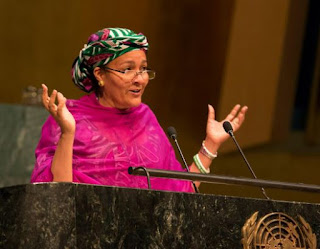Deputy Secretary-General's remarks to the Green Climate Fund Private Investment for Climate Conference [as prepared for delivery]
The COVID-19 pandemic has upended lives and economies around the globe.
The consequences for low- and middle-income countries, in particular, have been devastating.
And for many communities around the world, the growing impacts of climate change have compounded their hardship.
We are entering a new era of climate disruption. Yet, this moment also presents us with a unique opportunity to chart a new path.
The choices we make today will determine the course of the next 30 years. The recovery from the pandemic must be an opportunity to create jobs, close the gender gap and reduce inequalities.
It must also put us on track to meet our climate targets. Emissions need to fall sharply and permanently, by about 8 per cent every year over the next decade.
We must achieve net-zero emissions globally by 2050 to limit global temperature rise to 1.5C degrees. We need all hands-on deck now.
I see four priorities.
First, we must prioritize investments that contribute to a low-carbon, climate-resilient recovery. These investments are good business: Per kilowatt hour, solar is now cheaper than coal in most countries. This is driving costs down for end users. Investments in renewable energy generate three times more jobs than those in fossil fuels.
Fossil fuels are increasingly risky business and they have fewer takers from investors around the world. The International Finance Corporation estimates a cumulative climate investment opportunity of USD $29.4 trillion across six urban sectors in emerging markets. These include green buildings, low-carbon public transport and electric vehicles, climate-smart water and wastewater management and infrastructure.
Second, Governments need to set a long-term vision by aligning their COVID recovery plans with their national climate commitments. Nationally Determined Contributions and Long-Term Climate Strategies should inform COVID recovery policy choices so that they are consistent with the objectives of the Paris Agreement.
This will provide the private sector, and particularly those with long-term investment horizons, with frameworks to guide investment decisions today. At this year’s UN General Assembly we heard from President Xi Jinping that China aims to become carbon-neutral before 2060 and to peak CO2 emissions before 2030.
The European Union also committed to make Europe the first climate-neutral continent by 2050 and is expected to cut its greenhouse gas emissions by at least 55 per cent by 2030. These announcements coming from major market-movers send a clear message. The transition from the “high carbon” global economy is coming, and it is coming fast.
Third, to all financial actors, public and private: to meet the challenges ahead, we need you to fully embed climate risks and opportunities in your decision-making and align your portfolios with the goals of the Paris Agreement and the Sustainable Development Goals.
As the UN SG Special Envoy Mark Carney has put it, “decarbonization is the greatest commercial opportunity of our time”. The early movers will reap the greatest benefits.
Fourth, finance for adaptation and resilience will be essential to protect people and productive assets.
I am encouraged by examples in the portfolio of the Green Climate Fund of investments that provide concessional finance to support Small and Medium Enterprises with access to credit for financing adaptation measures, particularly in the agriculture sector.
But we need to significantly scale up adaptation finance. Development finance institutions also need to make much greater efforts to simplify and improve access to climate funds, especially for Small Island Developing States and the Least Developed Countries.
In conclusion, let me say that the important work of the Green Climate Fund is required more than ever as we accelerate the decarbonization of the global economy and strengthen resilience and adaptation across the developing world.
Let us continue to work together for a low-carbon, resilient future that leaves no one behind.
Thank you.




Comments
Post a Comment